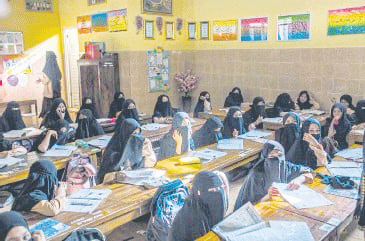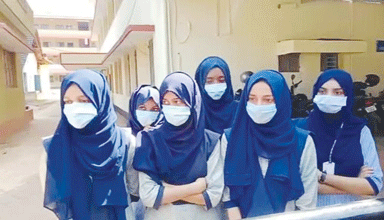BARRED: Large group of young Muslim women are being barred from entering their pre-university colleges (PUC) if they are wearing a hijab.
By Ipsita Chakravarty, Johanna Deeksha, Tabassum Barnagarwala & Aishwarya Iyer
For Muslim women the hijab is part of their normal wear. To ask them to do away with it in public is akin to stripping them of their private identity
In a conservative country where women are forced to cover up, the scenes out of Karnataka are drawing sharp reactions – but not always of solidarity.
The teacher strides up to the school gate, holding a clutch of bags. She first takes off her hijab, or headscarf. Then, heckled by others, she puts down the bags, unbuttons her burkha, lifts the garment over her head – in full public view.
Watching the scene captured on camera outside a school in Karnataka’s Mandya district on Monday, Shantamma Narayana, a 43-year-old cook in Bengaluru, shook her head side to side. “This is wrong,” she said. “They would feel embarrassed to remove it at the gate.”
It wasn’t just the humiliation – Narayana also saw this as a case of the religious freedoms of Muslim women being undermined. “If their religion requires them to wear” the burkha and the hijab, she asked, “how can they be stopped from doing so?”
What began as a dispute in a handful of colleges in Karnataka, where hijab-wearing Muslim students were denied entry to their classes in December, has now escalated into a national controversy which is testing India’s claims of being a secular country with freedom of religion.
With an interim order of the high court triggering a statewide ban on religious attire in schools and colleges this week, images of Muslim students and teachers being forced to remove their hijab in Karnataka have travelled across the country over social media.
In the public sphere, it is mostly men who are debating whether women should be allowed to wear the hijab in public, whether it was a regressive practice.
Some Muslim women have taken to social media to point out their right to choice and register their disquiet about the “humiliation” meted out to the teachers in public. As researcher Shireen Azam said on Twitter, India is a conservative country, where the public impulse is to cover women up. But Muslim women in Karnataka are being denied even this “patriarchal humanity” that the country had to offer.
What do their non-Muslim counterparts think about the videos, which show scenes that some have described as a kind of “disrobing”?
The answers, we found while speaking to women in four cities, varied greatly, depending on their religious identity, social milieu and individual experiences.
Prejudice against Muslims
Nijinagnamma Sutar, 46, lives in a slum in Mumbai’s Andheri suburb. “I think there is no harm in removing the burkha outside school or college,” she said. “Why should students take their religion to a classroom? Do Hindus do that?”
Before she came to Mumbai, married off by her parents at the age of 12, Sutar grew up in Bankalgi village in Karnataka’s Bijapur district, part of the erstwhile princely state ruled by the Nizam of Hyderabad.
As a native of Karnataka, Sutar has closely followed all the developments in the hijab controversy on TV – from Muslim students sitting on protest in December, to Hindu students wearing saffron scarfs as a form of counter-protest, and now, images of Muslim students and teachers taking off their hijabs and burkhas in public view, often amid sniggering men.
What unsettles Sutar aren’t these images, but the sight of a hijab-clad woman. The slum where she lives, Gilbert Hill, has a substantial Muslim population. Sutar even complained about the noise created by the mosques around her.

Sutar wasn’t the only one who used the language of uniformity to justify religious prejudice.
In Delhi, Indu Seth had not heard about the hijab ban in Karnataka’s educational institutions – or the saffron scarf protests by Hindu students. But she was not surprised when she was briefed about it.
“This is bound to happen,” she said. “Hindus will say they will wear the bhagwa [saffron] colour and Muslims say they will wear the burkha. Either both communities should wear it, or both should not be allowed.”
When it was pointed out that saffron scarves weren’t traditional attire and Hindu students were wearing them merely as a mark of protest, Seth said, “Ye toh Hindu jaage der se…” Hindus have woken up late.
Like Sutar, Seth grew up in an area with a large Muslim presence – Moradabad in Uttar Pradesh, where four of ten people belong to the community. After her husband died five years ago, the 56-year-old has been running her family’s chemist shop in Delhi.
She was unperturbed by the videos of Muslim students and teachers removing their burkhas and hijabs in public. “See, the burkha basically means that you do not want other people to see you, but what is the problem entering a school without it?” she asked. “We consider school a temple for education only, right? In a school, this should not matter.”
The only concession she was willing to make: “This should happen a little privately, and not openly on the street. So many people are walking by, who knows with what eyes they are looking at them.”
She suggested that Karnataka authorities make an enclosed booth for Muslim women to remove their burkhas, like the ones where women passengers were frisked in Delhi’s metro stations. But, then, she added, with a laugh: “Why are they covered? We are a thing of nature only, right? We all are
‘Everyone should be the same’
Other women who also felt the need for uniformity in the public sphere still empathised with the teachers being made to take off their hijab in front of strangers.
In Kolkata, 72-two-year-old Mamata Rai said: “It’s better for everyone to be the same in public now. No one sees Hindu-Muslim anymore.”
But Rai recalled that the burkha was a “matter of honour” for Muslim women in Bangladesh, which she left in 1963, at the age of 13. Her father, fearing for his family in a Muslim-majority country, had sent her over. Married off at 14, she has been a domestic worker in Kolkata for decades.
She does not have a phone and barely watches television, apart from the occasional religious programme. She had not heard of the Karnataka hijab ban, but as she peered into the phone screen to watch the videos, she felt it was not right.
“They shouldn’t make them take it off in front of everyone,” she said. “If I have to change my clothes with five people watching me, I won’t like it.”
Bidita Debnath, a 30-year-old public relations professional in Bengaluru, said she preferred religious identity taking a backseat in school campuses. But she added that asking women to remove the burkha in a public space amounted to “violating a person’s identity”.
“It’s like taking off clothes in public,” she said. “Women would feel exposed in a way that can’t be explained in words.”
Diversity, not uniformity
But the controversy isn’t about clothes at all, Alisha Nazareth, 26, a video editor from Goa, who currently lives in Mumbai, pointed out. Rather, it reflected the growing trend of religious minorities in India being bullied by the Hindu majority, she said.
“Would these same professors be comfortable if someone told their wives not to wear a ghunghat or to take it off?” she asked. “How can we call ourselves a diverse nation if there aren’t equal rights?”
Nazareth added: “It’s sick to watch these videos. Imagine how badly it must be affecting the kids psychologically.”
Simran Sandhu, 28, was similarly appalled. “It is not just unethical, it is also shameful to see where we are blindly headed as a nation.”
Born and raised in a Sikh family that lives in Rourkela, Odisha, Sandhu studied in Kolkata before she moved to Mumbai to work as a social media manager. She said the hijab ban goes against the prime minister’s call for “Beti Bachao Beti Padhao” – save the daughter, educate the daughter.
“Young girls who had to fight their way to go to college and school will now be dropping off the courses,” she said. “Because no parent would want to see these distressing videos, and would do everything in their power to ensure their daughters don’t feature in the next video.”
Amarjeet Kaur, 48, said what mattered was the autonomy of Muslim women and girls – not what they wore. “If they are being held at gunpoint to wear all this, then I understand, but if the women are choosing to do so, like it is visible in these videos, where the girls are talking for themselves, then it should be fine,” she said.
Kaur, a science tutor in Delhi, believes that every religion comes with its set of oppressive practices. “Even Hinduism is filled with so many rituals that are sexist. To quote one example, why should a woman starve for her man?” she said, referring to the practice of Karwa Chauth.
To the claim that Muslim men used religion to impose the burkha and hijab on women of their community, Kaur asked, “If you say their religion is oppressing them then are you not doing something worse? You are disrobing them in public…”
Kaur said India is supposed to be a secular country and if people were really interested in tackling oppression, they should focus on the rising levels of unemployment.
Economic crisis
The hijab debate has erupted at a time when most Indians, particularly from the working class, are coping with unprecedented economic hardship. Many women, weighed down by struggles exacerbated by the pandemic, were resigned to government diktats.
Bindu Mahato, who sells vegetables at a roadside stall in Kolkata, spoke about the hijab ban as “an order from above” aimed not at humiliating Muslim women, but simply “checking” them.
“Listen, a lot goes on in the name of the burkha,” she said. “A lot of dirty things.” It was not just Muslims, she continued, young people were being lured in the name of party and religion, whether it was by “pandits” or people “wearing tulsi beads”.
She was concerned about her young son. She had raised him on her own after her husband went out one day, 30 years ago, saying he was going to work and never returned.
The son is now grown up and has a job, but she worries about him being led astray by political parties. “I don’t trust anyone,” said Mahato, bitterly.
Ramakka C, a 70-year-old domestic worker in Bengaluru, has also had a life of struggle. After a long day’s work, as she peered into the phone screen to watch the videos of Muslim students and teachers taking off their hijabs, she asked: “Who brought this rule? When?”
She asked if nobody in the government had stood up for the women. “No government official spoke against it? The collector or the MLAs? Someone should have said something,” she said.
Ramakka said near her hometown in Chittoor, Andhra Pradesh, many women wore burkhas, but not so much in Bengaluru. “But if the government has brought the rule, then what can we say?” she said. “We just have to do what the government tells us. To fill this,” she said, putting her hands on her stomach.
Courtesy: The Scroll
